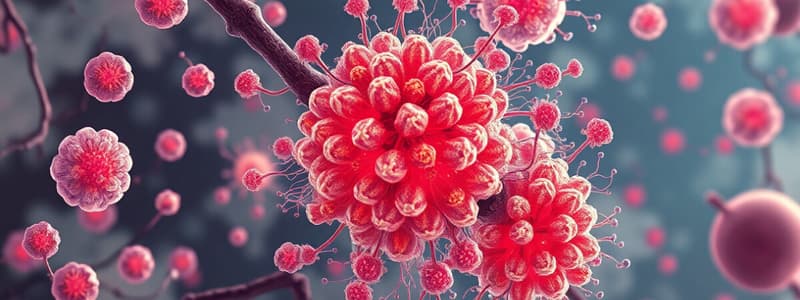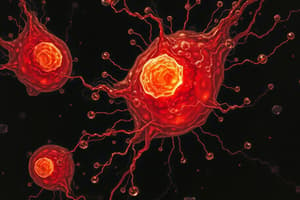Podcast
Questions and Answers
Which of the following factors can accelerate the development of mutations leading to cancer?
Which of the following factors can accelerate the development of mutations leading to cancer?
- Regular exercise
- Eating fruits and vegetables
- Tobacco use (correct)
- Drinking water
Only a small percentage of circulating tumor cells (CTCs) can form metastatic tumors.
Only a small percentage of circulating tumor cells (CTCs) can form metastatic tumors.
True (A)
What is the role of angiogenesis in the development of metastasis?
What is the role of angiogenesis in the development of metastasis?
Angiogenesis promotes the development of new blood vessels that provide pathways for cancer cells to enter circulation.
To survive in circulation, cancer cells are often coated by ______ to protect against immune detection.
To survive in circulation, cancer cells are often coated by ______ to protect against immune detection.
Match the following components with their functions in cancer metastasis:
Match the following components with their functions in cancer metastasis:
What must metastatic cancer cells do to invade new tissues?
What must metastatic cancer cells do to invade new tissues?
Local carcinoma is generally lethal without progression to metastatic cancer.
Local carcinoma is generally lethal without progression to metastatic cancer.
What characteristic do successful metastatic cancer cells exhibit to evade the immune system?
What characteristic do successful metastatic cancer cells exhibit to evade the immune system?
What helps cancer cells navigate endothelial barriers?
What helps cancer cells navigate endothelial barriers?
Cancer cells must adapt to new tissue environments to establish colonies.
Cancer cells must adapt to new tissue environments to establish colonies.
What is the Seed-Soil Hypothesis?
What is the Seed-Soil Hypothesis?
Cancer cells can become motile and invasive through the process of __________.
Cancer cells can become motile and invasive through the process of __________.
Match the type of cancer with its preferred metastatic site:
Match the type of cancer with its preferred metastatic site:
Which pathways are activated during the Epithelial-Mesenchymal Transition (EMT)?
Which pathways are activated during the Epithelial-Mesenchymal Transition (EMT)?
Cancer cells can revert from a mesenchymal state back to an epithelial state through Metastatic Epithelial Transition (MET).
Cancer cells can revert from a mesenchymal state back to an epithelial state through Metastatic Epithelial Transition (MET).
How do cancer cells suppress the immune response?
How do cancer cells suppress the immune response?
To invade new tissues, cancer cells rely on the degradation of the __________ and ECM.
To invade new tissues, cancer cells rely on the degradation of the __________ and ECM.
What drives cancer cells to execute complex steps quickly, such as invasion and metastasis?
What drives cancer cells to execute complex steps quickly, such as invasion and metastasis?
Flashcards
Metastatic Cancer
Metastatic Cancer
Cancer that has spread from its original site to other parts of the body.
Circulating Tumor Cells (CTCs)
Circulating Tumor Cells (CTCs)
Cancer cells that have broken away from a primary tumor and are circulating in the bloodstream.
What allows cancer cells to escape the primary tumor?
What allows cancer cells to escape the primary tumor?
Cancer cells secrete proteinases that break down the basement membrane and extracellular matrix (ECM), allowing them to escape the tumor.
Angiogenesis and Lymphogenesis
Angiogenesis and Lymphogenesis
Signup and view all the flashcards
How do cancer cells survive in the bloodstream?
How do cancer cells survive in the bloodstream?
Signup and view all the flashcards
Immune Evasion
Immune Evasion
Signup and view all the flashcards
What happens to the majority of CTCs?
What happens to the majority of CTCs?
Signup and view all the flashcards
What's the difference between primary and metastatic cancer?
What's the difference between primary and metastatic cancer?
Signup and view all the flashcards
Extravasation in Metastasis
Extravasation in Metastasis
Signup and view all the flashcards
Motility and Structural Flexibility for Metastasis
Motility and Structural Flexibility for Metastasis
Signup and view all the flashcards
Endothelial Navigation
Endothelial Navigation
Signup and view all the flashcards
ECM Degradation in Metastasis
ECM Degradation in Metastasis
Signup and view all the flashcards
Seed-Soil Hypothesis
Seed-Soil Hypothesis
Signup and view all the flashcards
Tissue-Specific Metastasis
Tissue-Specific Metastasis
Signup and view all the flashcards
Epithelial-Mesenchymal Transition (EMT)
Epithelial-Mesenchymal Transition (EMT)
Signup and view all the flashcards
EMT in Cancer Metastasis
EMT in Cancer Metastasis
Signup and view all the flashcards
Mesenchymal-Epithelial Transition (MET)
Mesenchymal-Epithelial Transition (MET)
Signup and view all the flashcards
Epigenetic Regulation of EMT and MET
Epigenetic Regulation of EMT and MET
Signup and view all the flashcards
Study Notes
Cancer Metastasis: Steps and Mechanisms
- Human cancers progress through a series of steps forming primary tumors, then potentially metastasizing.
- Factors like fast food, processed meat, and tobacco use accelerate mutation development, impacting cancer progression, including lung cancer.
- Primary tumors can become metastatic, posing a greater threat than local cancer.
Development of Metastatic Cancer
- Circulating Tumor Cells (CTCs) are shed from primary tumors into the bloodstream.
- A minuscule fraction (less than 0.01%) of these cells become metastatic.
- Metastatic cells must meet specific requirements:
Metastatic Cell Requirements
-
Leaving the Primary Tumor:
- Proteinases degrade basement membrane and extracellular matrix (ECM), enabling escape.
- Key enzymes involved: Type IV Collagenase and Cathepsin B.
-
Entering the Circulation:
- Angiogenesis and lymphogenesis establish pathways for cancer cell entry.
- Cancer cells separate, exhibit motility to move towards blood/lymph vessels.
-
Surviving in the Circulation:
- Platelets coat cancer cells, protecting them from immune response and stress.
- Selectin-mediated binding of platelets creates a protective layer.
-
Overcoming Host Defenses:
- Low immunogenicity and immune suppression are common.
-
Extravasation (Exiting Blood Vessels):
- Cancer cells navigate non-porous blood vessels at distant sites.
- Motility, flexibility, and activation of specific genes needed.
- ECM & basement membrane degradation facilitates invasion of new tissues.
-
Establishing a Metastatic Colony:
- Cancer cells adapt to new tissue environments; establish colonies.
- The Seed-Soil Hypothesis describes the need for compatible tissue environments.
Seed-Soil Hypothesis
- A tumor's metastatic potential depends on interactions with tissues promoting growth and survival.
- Specific tissues are "best soil" for particular cancers (e.g., prostate cancer to bone).
- Cancer cells select the optimal environment for growth, similar to seeds choosing favorable soil.
EMT and MET: Cellular Transformation
-
Cancer cells employ normal biological processes, such as the epithelial-mesenchymal transition (EMT), for metastasis.
-
EMT (embryonic process) allows cells to transition from non-motile, structured epithelium to motile, flexible mesenchyme.
-
In Cancer: Epithelial cancer cells, undergoing EMT, reduce epithelial markers and gain mesenchymal properties.
-
This enables invasion, entry into circulation, and survival.
-
Mesenchymal cells are adapted for motility, invasion, and circulation.
-
Cells re-establish the epithelial structure (MET) at the secondary site, forming new tumors.
-
Metastatic process largely driven by epigenetic modifications.
-
Key transcription factors (TFs), activated by pathways like Hedgehog (Hh) and Wnt—critical in embryonic development—are frequently involved in cancers.
-
Initial mutations in regulatory genes (e.g., APC) can drive cancers into EMT-related pathways.
Studying That Suits You
Use AI to generate personalized quizzes and flashcards to suit your learning preferences.




